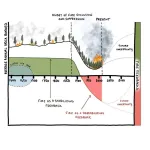(Press-News.org) Fewer wildfires burn in North American forests today than in previous centuries, increasing the risk of more severe wildfires, according to research published this week in Nature Communications. The findings may seem counterintuitive, but frequent low-lying surface fires often maintain balance in forests by reducing fuel sources across large areas.
The new study led by the Cooperative Institute for Research in Environmental Sciences (CIRES) at the University of Colorado Boulder and the U.S. Forest Service’s Rocky Mountain Research Station compared wildfire frequency between two time periods: 1984 to 2022 and 1600 to 1880. Scientists analyzed 1,850 tree-ring records in historically burned areas and compared them to maps documenting the perimeters of modern fires across Canada and the United States.
The findings show modern-day fires are much less frequent than they were in past centuries, despite recent record-breaking fire years, such as 2020. The results also reveal that much of the continent is in a substantial “fire deficit,” experiencing about 20 percent as much fire as in the past. On average, larger areas of land burned from fires each year before 1880 compared to 1984-2022. This deficit allows fuel to build up over time, creating conditions for more severe fires.
“It’s a harbinger for far more bad fires to come unless we can get more beneficial management fires on the landscape,” said Chris Guiterman, a CIRES research scientist and member of NOAA’s National Centers for Environmental Information (NCEI) paleoclimate team.
Even though a much larger portion of the forest burned in fires in the 18th and 19th centuries, those fires were less devastating: the trees that recorded those fires survived and continued to grow. Modern fires, in contrast, are so severe they often leave forests barren and speckled with dead trees.
According to the researchers, the differences between historical and contemporary fires likely reflect the changed relationship between fire, forests, and people across much of the U.S. and Canada. Before 1880, fires burned more frequently but less severely across many forests due to traditional burning practices by Indigenous peoples and lightning-sparked fires. These fires often had a stabilizing effect on the forests by clearing out brush and debris—lowering the amount of flammable forest fuels available.
The disruption of traditional burning practices, widespread livestock grazing, and later suppression of human and lightning-ignited fires have prevented beneficial forest fires from igniting across the U.S over the past century. This has destabilized forests that evolved with and are adapted to fire. Today’s higher-severity wildfires are more likely to harm people and communities while transforming forests into other vegetation types such as shrublands.
This study complements recent research demonstrating that historical fires burned less severely and coincided with drought episodes over large regions.
Wildfires are inevitable in forests across the Western U.S. There is an ever-growing body of science around practices to help reduce the probability that these fires will have adverse impacts on forests and humans. Previous research shows that activities such as mechanical fuel treatments and prescribed burning are effective ways to reduce fire impacts, and are in line with both Indigenous management practices and long-term ecological processes.
“It’s heartbreaking to witness how recent wildfires are devastating people, communities, and forests,” said Sean Parks, research scientist with the U.S. Forest Service Rocky Mountain Research Station, and lead author of the study. “Wildfires are inevitable, so preparing our forests for these events through fuel reduction treatments and prescribed fire will reduce their impacts to communities and forests.”
END
Fewer forest fires burn in North America today than in the past—and that's a bad thing
2025-02-12
ELSE PRESS RELEASES FROM THIS DATE:
Older people in England are happier now than before the COVID pandemic, new national study suggests
2025-02-12
Older people have greater general happiness, life satisfaction and sense of purpose than they did before the Covid-19 pandemic.
That’s according to a new study which tracked 3,999 over 50s in England for 11 years, published today in the peer-reviewed journal, Aging and Mental Health.
Analysing data to understand positive psychological well-being and depression within this group, an expert team from UCL (University College London), funded by the National Institute of Ageing, a consortium of UK government departments coordinated by the National Institute ...
Texas A&M chemist wins NSF CAREER Award
2025-02-11
Dr. Alison Altman, an assistant professor in the Texas A&M Chemistry Department, has received a National Science Foundation (NSF) CAREER Award, which supports early-career faculty in research and education. The award recognizes her work on underexplored elements of the periodic table and her dedication to teaching. For Altman, it’s a launchpad for future discoveries.
“It’s an honor to receive this award, as it acknowledges not just my research program but also my teaching efforts,” ...
Micro-nano plastics make other pollutants more dangerous to plants and intestinal cells
2025-02-11
Micro- and nanoscale plastic particles in soil and water can significantly increase how much toxic chemicals plants and human intestinal cells absorb, according to two new studies from Rutgers Health that raise fresh concerns about food safety from plastic pollution.
The first study in NanoImpact found that lettuce exposed to both nanoscale plastic particles and common environmental pollutants such as arsenic took up substantially more of the toxic substances than plants exposed to the pollutants, alone confirming the risks of polycontamination of our food chain. A companion study in Microplastics journal showed ...
Study of female genital tract reveals key findings
2025-02-11
Seeking to understand what constitutes a healthy vaginal microbiome, a global research collaboration that includes a Rutgers-New Brunswick scientist has reported a series of findings, including identifying which bacteria thwart vaginal disease and determining that microbiomes vary significantly across human populations.
Authors of the study, published in Trends in Microbiology, are part of a Belgium-based initiative called the Isala Sisterhood. Members of the group aim to inspire research on microbiomes worldwide by creating a “reference map” of vaginal microbiota. Launched in 2020 at the University of Antwerp, the project has expanded to include more than 3,000 ...
Pitt Engineering Professor Fang Peng elected to National Academy of Engineering
2025-02-11
The National Academy of Engineering (NAE) today announced that University of Pittsburgh Professor Fang Peng, an internationally acclaimed power electronics researcher, is among the newest cohort elected to the academy. The NAE is recognizing Peng for “contributions to the development of high-powered electronic technologies for advanced power grid and energy conversion.”
Peng, the RK Mellon Endowed Chair Professor of Electrical and Computer Engineering and Director of the Energy GRID Institute at Pitt’s Swanson School of Engineering, ...
Short-course radiation therapy effective for endometrial cancer patients
2025-02-11
In a randomized clinical trial, researchers from Huntsman Cancer Institute at the University of Utah (the U) have found that short-course, higher dose vaginal brachytherapy for endometrial cancer had similar effectiveness to more frequent, lower dose sessions.
Gita Suneja, MD, MS, physician-scientist at Huntsman Cancer Institute and professor of radiation oncology at the U, is the first author of the SAVE trial report—which stands for, Short-Course Adjuvant Vaginal Cuff Brachytherapy in Early Endometrial Cancer Compared with Standard of Care.
“There ...
Breast cancer treatment advances with light-activated ‘smart bomb’
2025-02-11
Scientists have developed new light-sensitive chemicals that can radically improve the treatment of aggressive cancers with minimal side effects. In mouse tests, the new therapy completely eradicated metastatic breast cancer tumors.
The novel chemicals, called cyanine-carborane salts, and their role in the next-generation of cancer treatments, are described in a new article published in Angewandte Chemie, a journal of the German Chemical Society.
Photodynamic therapy, or PDT, has been used for decades to treat forms of skin and bladder cancers. It works by flooding a patient’s body with light-sensitive chemicals that accumulate in cancer cells. ...
JSCAI article at THT 2025 sets the standard for training pathways in interventional heart failure
2025-02-11
WASHINGTON–Interventional heart failure (IHF) has rapidly evolved as a critical subspecialty within cardiology at the crossroads of advanced heart failure and interventional cardiology. The increasing complexity of patient care—spanning both pharmacological treatments and an expanding array of device-based therapies—has underscored the urgent need for a standardized approach to training and career development in this field.
That’s the message from experts in a comprehensive review, “Charting the Course for Careers in Interventional Heart ...
Engineering biological reaction crucibles to rapidly produce proteins
2025-02-11
Biomedical engineers at Duke University have demonstrated a new synthetic approach that turbocharges bacteria into producing more of a specific protein, even proteins that would normally destroy them, such as antibiotics.
The technique directs bacteria to produce synthetic disordered proteins that bunch together to form compartments called biological condensates. When these compartments trap mRNA carrying instructions for specific proteins together with the machinery needed to implement them, they can greatly enhance the rate of protein production.
The technique could be a boon to industries that use bacteria to produce a wide range of products such as pharmaceuticals, ...
Minecraft: a gamechanger for children’s learning
2025-02-11
It’s the globally popular video game that’s captured the attention of more than 141 million active players, but Minecraft can also play a significant role in shaping children’s development, social interactions, and cognitive learning, say researchers at the University of South Australia.
Published in the new book Children’s online learning and interaction, the study found that when children engage in collaborative Minecraft play, they foster teamwork, communication, and social skills as players exchange ideas and problem-solve ...






